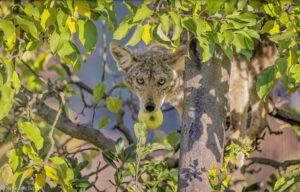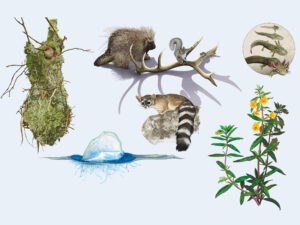Years ago, in my mother’s garden, an ominous mound appeared: a volcano- or horseshoe-shaped pile of earth with an off-center hole, plugged with loose dirt. Her response, echoing the response of generations of frustrated gardeners, was to reach for a shovel and try to destroy the burrow, but a season’s worth of bulbs fell prey to gnashing incisors. The culprit was a Botta’s pocket gopher, also called a western or valley pocket gopher, one of a family of rodents named for the fur-lined cheek pouches they use to store food while foraging. Though gophers are considered pests by people trying to maintain gardens and lawns, they’re just another part of functioning ecosystems in the wild habitats where they evolved and still thrive.
The word gopher is derived from the French gaufre, meaning corrugated or honeycombed, an apt description of their burrows. Gopher burrows are typically arranged around a central corridor, or runway, with numerous side chambers and passages for food storage, waste disposal, and nesting. All told, these tunnels can attain a total length in the hundreds of feet—quite spacious for a solitary rodent. And a single gopher can move upwards of a ton of dirt to the surface each year. (Vengeful gardeners, take note: your attempts to cave in passageways or seal up entrances are unlikely to slow them down a whit.) Gophers themselves are well suited to the burrowing lifestyle: small ear flaps and a body not much wider than their head keep them streamlined. Bristly whiskers, a well-developed sense of smell, and a tactile, nearly hairless tail help them navigate in the dark. To penetrate hard-packed substrate, they use robust claws and chisel-like incisors that protrude forward even when their lips are sealed to keep dirt out of their mouths.
Their ability to create a home for themselves under the ground wherever they go accounts for the diversity of habitats in which they can be found. Botta’s pocket gophers live all over California and throughout southwestern North America, in environments ranging from alpine meadows to arid valleys. Their preference for roots, tubers, and other moist plant parts means that they can survive when water is scarce, and the several meters of earth between them and the surface insulates them from harsh temperatures. Pocket gophers will even dig burrows under several feet of snow. Spring snowmelt often reveals gopher eskers—spiderwebbing trails of soil on the surface that once lined snow tunnels.
- Irrigated lawns often raise bumper crops of gophers-which in turnattract hungry great blue herons like this one, taking a detour fromits usual wetland habitat. Photo by Rick Lewis.
Though they are territorial and intolerant toward others of their kind (except for a brief breeding period each spring), pocket gophers frequently share their tunnels with a wide array of other organisms. Gopher burrows in moist earth make ideal shelters for amphibians, especially when vernal pools or other surface waters dry up. One study in Southern California found nearly as many tiger salamanders as gophers in the burrows. Additionally, abandoned gopher holes are usually quickly appropriated by snakes, lizards, and other rodents.
Their propensity for moving so much earth (“bioturbation” to ecological vocabulary fans) also has important benefits for the soil and the gardeners who cultivate it. Runoff from rain or snow often collects in gopher burrows and sinks in to the earth, reducing flooding and erosion and providing natural irrigation. Scraps of vegetation and waste material mix organic nutrients into the soil, increasing fecundity. Loose soil from mounds or collapsed tunnels provides a porous medium for many beneficial organisms, including earthworms. My mother, dedicated as she is to her bulbs, may be forgiven her immoderate reaction. But gophers, like many of nature’s mixed blessings, are best dealt with through patience, understanding, and perhaps a bit of chicken wire.
More information on pocket gophers
www.sacsplash.org/critters/gopher.htm
www.enature.com/flashcard/show_flash_card.asp?recordNumber=MA0104
www.desertusa.com/mag01/jun/papr/gopher.html (pictures and videos of burrowing)

.jpg)




